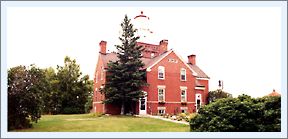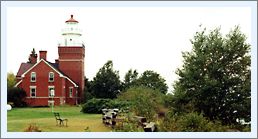 |
 |
|
Click on thumbnails to view enlarged versions |
|
| Big Bay Point Light | Seeing The Light |
|
|
|
|
Historical
information
The lighthouse was built as a two-story brick duplex dwelling, 52 feet by 52 feet with 18 rooms. The light tower rose from the center of the house 105 feet above Lake Superior. There were also two small brick outhouses, a brick oil storage building, and a 20 foot by 15 foot brick fog signal building. The first fog signal consisted of two steam operated ten-inch train whistles that protruded from the roof of the building. In 1928, these whistles were replaced by duplicate diaphone signal systems. On October 20, 1896 the fixed Third Order Fresnel lens was placed into service. According the Keeper's log entry of June 8, 1887, the lens was "fitted with a 3 wick burner same as a 2nd order light and consuming the same quantity of oil." With a focal plane of 105 feet, the steady white light was increased to a brilliant white flash every 20 seconds by rotating bulls eye panels in the lens system.
As the country moved towards the eight-hour workday, a third assistant was added to the station. A frame dwelling and outhouse were built for his use near the fog signal building at the bottom of the hill. H. William Prior was appointed first Head Keeper at Big Bay, and assumed his duties at Big Bay on August 15 1896 after transferring-in from Stannard's Rock Light. Prior served in this position until his untimely demise on June 27, 1901. Click here to read Prior's fascinating and tragic story, as told largely in his own words from the Big Bay Keeper's Logbook. In 1941, under the authority of the US Coast Guard, the last keeper was reassigned and the light at Big Bay was automated. The assistant keepers' side of the lighthouse was rented-out. First to a Big Bay schoolteacher and her veteran husband as a year round home, and later as a summer home to two different families from the Marquette area.
The soldiers camped-out in the meadow and woods to the West of the lighthouse. In 1952, a soldier stationed at the lighthouse committed a murder at the Lumberjack Tavern in Big Bay. The movie "Anatomy of a Murder," which was filmed in Big Bay, Marquette and Ishpeming, was based on this unfortunate incident. In 1961, the Lighthouse and 33 acres of land were sold by sealed bid to Dr. John Pick, a plastic surgeon from Chicago, for the sum of $40,000. Having been abandoned for close to six years, the lighthouse had fallen into terrible disrepair. With most of the roof missing, numerous broken windows, and plaster falling from the walls, Dr. Pick set out to rehabilitate the proud structure into the summer home of his dreams. It took most of Dr. Pick's seventeen years of ownership to achieve his dream. He installed inside plumbing, electricity and a modern heating system; re-plastered many of the walls, repaired windows, opened the duplex into one large building and added a fireplace to the living room. He then set out to furnish the lighthouse with the antiques he had collected in his world travels, including the ships' wheel from the Normandy. In his 80's and in poor health, Dr. Pick sold his beloved dream house in to Dan Hitchens of Traverse City in 1979. Mr. Hitchens added bathrooms to most of the 7 bedrooms, a sauna in the tower and opened the Lighthouse as a conference and retreat area for corporate executives. Five years later, with business in a slump and a need for cash, Dan sold the lighthouse to a three-man corporation. One of those men was Norman "Buck" Gotschall. Buck reopened the lighthouse as a Bed-and-Breakfast in 1986. Buck restored the Fog Signal House, retrieved the 3rd order lens from the Park Place Hotel in Traverse City and had it reassembled for display in the fog building. As land around the lighthouse became available, Buck and his partners bought as much as possible until in 1991 the lighthouse was surrounded by close to 100 acres. Buck cleared a landing strip for his 1957 tri-pacer to the south of the lighthouse. Hiking trails were cleared and some locally created sculptures installed in the meadow near the Fog House. Buck married in 1989, and his new bride Marilyn added that much-needed woman's touch to the Bed and Breakfast. Nearing retirement, Buck and his partners decided to sell. In March 1992, three avid preservationists from the Chicago area became the fourth and present owners. John Gale, Linda and Jeff Gamble had been guests at the Bed and Breakfast and fell in love with the lighthouse and the tiny hamlet of Big Bay on their first visit. On a return visit in 1991, they learned that the lighthouse was for sale and that one very interested party wanted to build Condominiums on the property. Not wanting to see that happen, they decided to make an offer on part of the acreage and the lighthouse. Much to their surprise the offer was excepted! When final papers were signed, Linda moved to Big Bay to run the Bed and Breakfast, while her husband Jeff, and their partner, John, remained at their jobs in Chicago. In July of 1994 Jeff joined Linda and
they continue to run the Bed-and-Breakfast. As of today John is still in
Chicago. We returned the next day at 10.00 a.m. and walked the grounds in a dismal drizzle. The light was terrible this day, as it painted everything with a dull, even cast. We took the uninspiring photographs seen above, and vowed to return again to photograph in a more inspiring light! On the way back to Marquette, we took a 12 mile detour down a sand road to photograph on of the areas waterfalls. After climbing up and down the falls, we were returning to the truck, when Sue stopped and started walking slowly toward the left rear tire. She pointed at a huge nail sticking out of the tire, and proclaimed proudly that she could hear it hissing from fifty feet away! We drove gingerly back to Marquette, checking the tire every couple of miles, and found a tire center that had it plugged in thirty minutes, and we were on our way again! The woman has incredible ears! Guided tours of the lighthouse are available May through September at
1:00 pm & 2:00 pm. Tuesday, Thursday, and Sunday with a $2.00
admission charged. The grounds are open daily from 10:00 am to 4:00 pm. Visitors are
required to park at the gate and walk 1/10 of a mile up to the
lighthouse. |